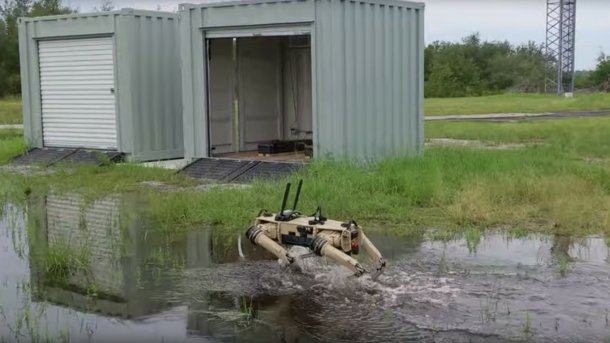U.S. Marines test autonomous robot dog with weapon system
The U.S. Marines are currently testing two robot dogs that can autonomously engage military targets. They do not want to use the autonomous function.

An early version of the Ghost Robotics Vision 60: The robot dog returns to its charging station through swampy terrain.
(Bild: Ghost Robotics (Screenshot))
The United States Marine Forces Special Operations Command (MARSOC) is testing two Vision 60 autonomous robot dogs equipped with weapons from the military equipment manufacturer Ghost Robotics. This was reported by the US magazine The Warzone on Tuesday. The two four-legged robots, known as Quadrupedal Unmanned Groud Vehicles (Q-UGV), can be flexibly equipped with different weapon systems. Together with a control system for the weapons, they form the Sentry Remote Weapon System (RWS) from Onyx. This also allows the robot dogs to autonomously engage military targets.
The four-legged Vision 60 robot dogs being tested weigh around 51 kg each and can carry a payload of around 10 kg. The two robots are designed to move over rough terrain. They can reach a top speed of up to 10.8 km/h, as Ghost Robotics states on its website. The MARSOC robot dogs can be on the move for up to three hours before they need to return to a charging station.
The Vision 60 carries the Sentry RWS as its payload. This is a combination of a weapon system that can be flexibly equipped with different calibers, the Remote Actuated Weapon (RAW), and a system for autonomous control of the weapon, which can be addressed via any communication network. This allows soldiers to operate the robots safely from a distance. Together, the two systems form the Onyx RWS.
Autonomous engagement of targets possible
The control system includes an X360 pan/tilt gimbal stack with a full electro-optical infrared unit and an AI-enabled optical recognition system. This enables the robot dog to independently detect and engage targets such as humans, military vehicles and other weapon systems and drones.
The primary intention is for a "man-in-the-loop", i.e. a human operator, to retain fire control. He is informed as soon as the Vision 60 has detected and locked onto a target and can then trigger the weapon system or not. However, the robot dog is also capable of engaging targets completely autonomously (Assign and Forget) without having to obtain human permission beforehand.
MARSOC remains silent on how and where Vision 60 is currently being tested. MARSOC does not claim to have used the option to engage targets autonomously. All current guidelines on the use of autonomous weapon systems are being followed. MARSOC points out that the Vision 60 robot dogs could also carry systems other than weapons and could be used for reconnaissance purposes in the area of Intelligence, Surveillance and Reconnaissance (ISR) and for electronic warfare (EW).
(olb)